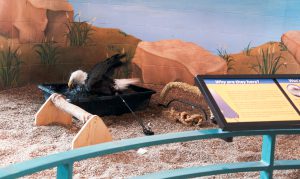
Written by: Erin Jones and Andrew Schouweiler
For years, eagles have had symbolic importance for many people and cultures.
In both American and Native American cultures, the eagle is culturally and historically significant for different reasons.
For the United States, the eagle is its national emblem, a symbol for independence and freedom. For Native Americans, the eagle has profound religious and cultural meaning, and its feathers are a crucial part of many Native American ceremonies.
It’s not just Native Americans and the United States who recognize the importance of eagles. The National Eagle Center in Wabasha, Minnesota is home to four eagles, who help volunteers educate visitors more about the symbolic bird.
Ed Hahn, the Eagle Center’s marketing manager, talked about the variety of visitors who come to the eagle center.
“Some people come here and a whole new world opens up to them. They’re going to learn a lot about [eagle] behavior, their life cycle, their habitat, things like that,” Hahn said. “Another group that has a very strong personal connection with eagles are both Native Americans and U.S Military veterans. Both of those groups come here, just about every day I would say, and you can just tell when they first meet the eagle ambassadors here at the eagle center that there is a connection they share with the ambassadors.”
James Reidy, associate professor of recreation tourism and therapeutic recreation at Winona State University and former zookeeper, explained why the Eagle Center is allowed to keep their birds.
“The National Eagle Center has educational permits and salvage permits to house the birds and the non-eagles are all those displays of taxonomy birds,” Reidy said. “So the federal government has several different permits depending on what you’re doing, so for the Eagle Center it’s those two.”

Travis Erickson is a quarter Dakota Native American and a fourth-generation pipe maker in his family. He explained the significance of eagles in Native American culture.
Erickson said Native Americans use eagle feathers because the eagle flies closer to Creator, which is the basis for the use of eagle feathers in tribes.
“That’s why they use the eagle feathers because he does fly that high, closer to Creator, but in our ceremonies it’s always good to have an eagle feather along with attached to your pipe when you smoke the pipe,” Erickson said. “The spirit of that eagle will take your prayers to Creator.”
Erickson said eagle feathers are associated with an individual’s status and feathers are typically earned or are a representation of a certain characteristic, like courage or wisdom, that a person has or wants to have.
“You always see the chief, he has the long headdress made with all kinds of eagle feathers,” Erickson said. “That’s his status in the tribe and I suppose even a medicine man or a spiritual man might have one, but it wouldn’t be as long as the chief’s would be.”
Native American people don’t just come across eagle feathers randomly. Just as there is a process for places like National Eagle Center to keep live eagles, there is a process for physically getting eagle feathers, as well as their carcasses, which are also important in Native American culture.
Reidy explained the process of distributing eagle carcasses and feathers to Native American tribes across the country.
“It’s a process and what happens is any bird that is injured or dies goes to the repository and there, the repository takes inventory,” Reidy said.
Eagle carcasses and feathers are then assessed for quality and shipped to Native Americans who have requested them through an online application. Sometimes it takes months or even years before a request is filled and a bird is sent out.
Reidy said the process for getting eagle parts has a long history. Governmental protection of bald eagles began in 1918, when the Migratory Bird Treaty Act passed.
“Historically, eagles were hunted for their feathers and things of that sort, not just the native populations, but others would want them and mount them,” Reidy said. “In Alaska, [eagles] were eating the salmon that were already dead, but the fishermen thought they were eating their fish, so they wanted to shoot them.”
Reidy said with the increase of animal habitat destruction and use of pesticides, the United States created the Bald Eagle Protection Act of 1940, which included golden eagles in 1962, as people could not differentiate between first-year bald eagles and adult goldens.
Protection of eagles went further when they were listed as an endangered species under both the Endangered Species Preservation Act of 1966 and the Endangered Species Act of 1973, making it illegal to hunt eagles or possess them.
According to Erickson, this presented a problem for Native Americans who needed eagle parts for their ceremonies.
“When they made the eagles illegal to hunt, then the tribal people got kind of upset a little bit and so [the government] said, ‘Well, it is a part of your culture, it is open to you guys, but you can’t hunt them.’,” Erickson said.
It was then, in the early 1970s, when the U.S. Fish and Wildlife Service developed the National Eagle Repository to allow Native Americans, as well as the National Eagle Center, to possess eagles and their feathers.
Erickson said despite the tedious process, eagle carcasses and feathers are a crucial part of Native American culture and are a sign of honor and respect, particularly for the animal.
“That’s pretty simply put,” Erickson said. “But you create the sacredness in those feathers when you receive [them].”
